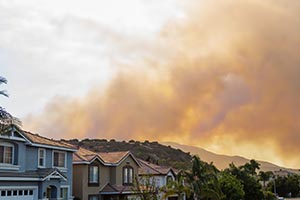
Checklist: financial recovery after a natural disaster

How to avoid falling for scams targeting digital payments

Updated February 14, 2025

Bounce back from a natural disaster with assistance from insurance, the government and the bank.
Insurance claims: File claims promptly and understand your policy's coverage, as not all disasters are covered under standard homeowners insurance.
FEMA assistance: Register with FEMA for additional financial help beyond insurance, especially for housing and essential expenses.
SBA loans: Consider low-interest loans from the Small Business Administration for recovery needs not covered by insurance or FEMA.
Bank support: Banks may be able to offer short-term relief like pausing payments and acting as liaisons with insurance companies.
Communication is key: Maintain constant communication with creditors to explore flexible payment options and long-term recovery solutions.
Wildfires, hurricanes, tornadoes and other natural disasters are by definition devastating – emotionally and financially. While the recovery period can linger long after the event ends, navigating key resources will be important to assess damage and regain financial stability.
“A disaster is a disaster to us, whether it’s one client or tens of thousands of clients,” says Nathan Hunt, senior vice president and default counseling manager at U.S. Bank. “We want to try to make the financial piece of it – which can be taxing for a client – to be as smooth and seamless as possible.”
As Hunt puts it, many “relief valves” are available to help you get back on your feet financially after a natural disaster. Read on to learn more about the critical roles of insurance, government disaster assistance and your bank. Plus, you’ll find out about steps to take if you find yourself among the millions of Americans that are affected by natural disasters every year.
Whether you’re a homeowner or renter, if your property was damaged, file a claim with your insurance agent ASAP. But take note: Not all insurance plans are created equally. Your specific policy will dictate the scope of coverage. For example, floods and ground movement (earthquakes, sinkholes and landslides) aren’t typically covered under standard homeowners insurance. Yet, hazard insurance can cover many disasters, including tornadoes or hurricanes.
Refer to policy documents for information about your coverage level. And if you’re not sure what your policy covers, it’s probably time to refresh. Some key questions to answer:
If possible, take photos or videos of your property to help support all claims. Establishing a paper (or digital) trail with comprehensive, detailed photos will help your case. Make an inventory list of all lost or damaged possessions. Also, record the claim number and date you called to make the claim. Keep a written record of all contact you have with the insurance agent and claims adjuster. And always hold onto and make copies of repair damage receipts or invoices.
If you’re affected by a federally declared disaster, you are urged to register with the Federal Emergency Management Agency (FEMA). Do so even if you have homeowners, renters or flood insurance. Be aware, though, that FEMA cannot duplicate benefits that are covered by your insurance. But you may be eligible for financial help with losses not covered or those in excess of your insurance coverage.
FEMA can also help with housing issues and money to cover additional costs, such as transportation, childcare and medical expenses. Keep in mind, FEMA grants are subject to audit. Make sure to keep your receipts or bills for which the money was used for three years.
If your insurance and FEMA grant doesn’t fully cover the assistance you need, you can also tap the Small Business Administration (SBA). The SBA offers assistance in the form of low-interest loans to renters, homeowners and businesses of all sizes affected by declared natural disasters. These disaster loans can cover a number of different purposes, from machinery to real estate. Repayment plans vary: up to seven years for working capital loans, 10 years for equipment loans and 25 years for commercial real estate loans.
“There are programs that clients can take advantage of,” Hunt says. “And we can work diligently with them throughout – from beginning to end – so clients are getting the right reprieve and protections, and that we are helping them get back on their feet from a financial perspective.”
Your bank may be able to:
If you have a mortgage, auto loan or student loans, Hunt says constant communication with your creditors is key. Let’s say damage to your workplace causes a decrease in income; a creditor may be able to help with flexible mortgage and home equity payment options to ease the financial burden.
If you’re still having financial difficulty, your bank may be able to extend relief with long-term recovery options, including loan modifications.
Want to learn more? Here's more information to help you regain control of your financial situation after a crisis.


